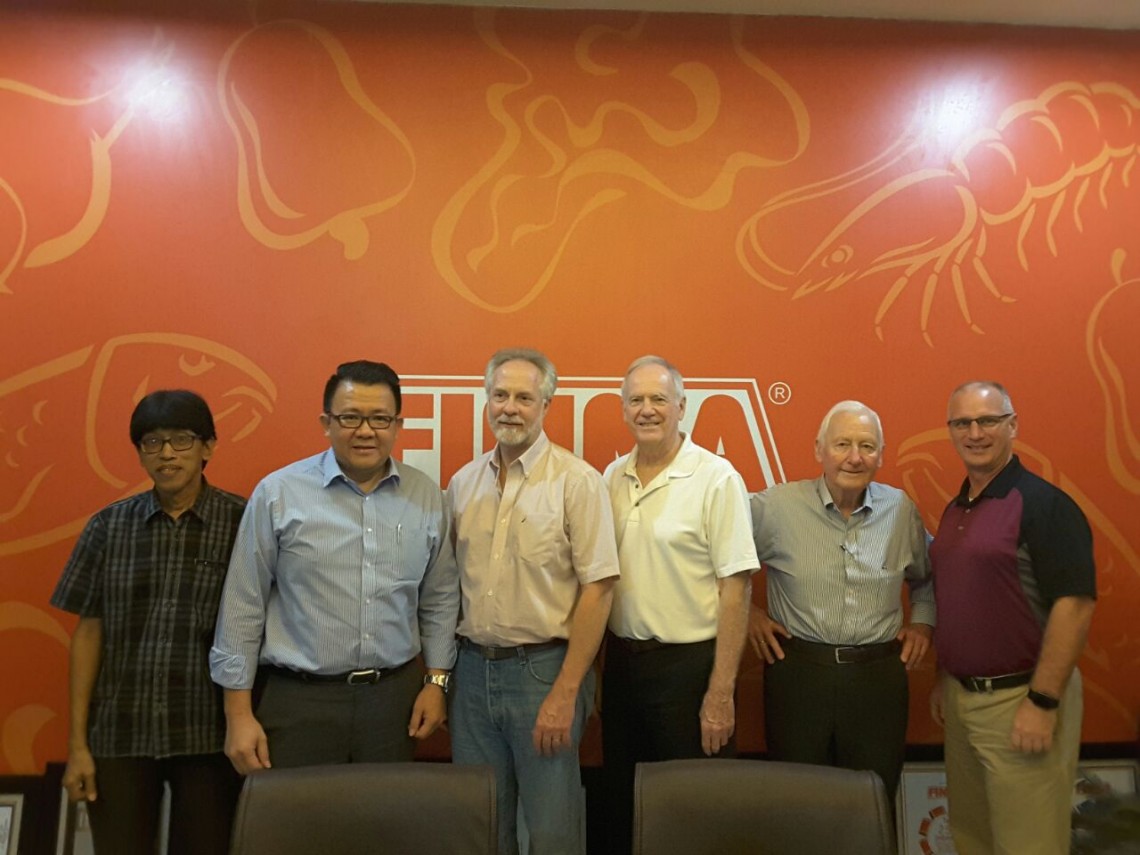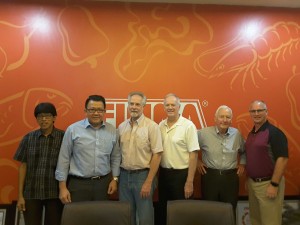During their assessment of Indonesia cold chain infrastructure to the government institution (collaborating with Indonesia Cold Chain Association, ICCA), here some notes:
A. From Ministry of Marine Affairs & Fisheries :
1. Ministry of Marine Affairs & Fisheries has focused on eliminating illegal fishing, 2. Fish production in growing, but cold chain system is falling behind, electricity is a problem, more budget is being devoted to this, 3. RI government considers fisheries and tourism a priority for economic development, 4. Already have sovereignty and sustainability in fisheries and now are focusing on prosperity, 5. We were shown a ppt of the Indonesian fish processing situation: a. 718 registered fish processing plants (421 process frozen fish products), does not include farm raised tilapi, b. Fish processing needs are substantially more than current capacity, c. Tuna, Ikan pelagis (a type of fish used in canning), and shrimp are the primary fish processed, 6. Showed project sites targeted for development: a. 12 in total throughout the country, b. Modernize 5 current locations, i.e Jakarta, Bitung (North Sulawesi), Jembrana (Bali), Sendang Biru (Jawa Timur), 7. Recommendations: a. Where do they need the most assistance?, b. Fish availability is mostly in Eastern Indonesia but population is mostly in Western Indonesia, c. One focus of development is to improve availability of electricity in the outer more remote islands. d. Want to develop areas where they can process the fish in the Eastern part and export directly from there to other countries, e. Electricity in Indonesia is very expensive. They recently decided to fix the price of fuel to be the same in all parts of the countries. f. Clean water is another constraint for refrigeration, g. What is the best cold chain system for Indonesia for improving the quality of their fisheries products in Indonesia for export?
B. From Ministry of Industry
Ministry of Industry has focused on growing up the competitiveness local cold chain industries regarding to ASEAN and Asia Free Trade Market.
1. Indonesian cold chain standards are based on the manufacturers standard specs, 2. They plan to increase local content of cold storage facilities. But now only about 10% is locally produced, 3. Can only provide about 30% of needs through local production, 4. US$ 200 million were invested in transportation and logistics in 2015, 5. Now in Indonesia they had a workshop to encourage local content, two brands have fabrication: Bitzer and Copeland, 6. Cold storage capacity in Indonesia is below the needs. They need 30 million MT equivalent but actual storage is only 10 million MT equivalent, about 30%, 7. Energy is a major problem especially in remote areas. They are trying to find alternative energy supplies including solar energy but batteries only last about 6 months, 8. They are in the process of trying to establish standards. They would be interested in receiving recommendations from the USA on US standards and/or standards that could be applied, 9. US standards for cold storage design and construction focus on safety and fire standards but not much on design or construction standards, 10. Building code requirements in the US must be followed and approved by a qualified engineer, 11. Now is a big opportunity for investing in logistics and transportation. So this sector is open for 100% Foreign Direct Investment (FDI), 12. GOI can give provide tax incentive for investment in cold chain logistics and storage, 13. Import duties are 0% for materials that are imported for investment in construction and can not be procured locally, 14. Ministry of Industry is very interested in investment from the US, 15. Important for them to learn more about cold chain technology and also cooperate with foreign investors, 17. They will develop a timeline for their plans to improve the system.
Note : National fresh product’s production that needed good cold chain system : 1. Fish and Seafood products 13.5 million tons, 2. Red Meat products 600 thousand tons, 3. Poultry and Chicken products 4.2 million tons, 4. Fruit and Vegetables products 25.5 million tons, 5. Dairy products and processed Food 1.3 million tons
Recommendations:
GCCA may wish to send experts to participate in their standards workshop being planned, maybe in January – February 2017
C. Besides assess to the Ministry, GCCA and ICCA also assessed to industries who entire cold chain system (manufacture, contractor, transporter, freight forwarder, sea port, dry port, end-user, processor, distributor, retailer, exporter-importer, etc). Here are some challenges, market potential, and other situation :
1. Manufacture insulated panels and doors for cold storage facilities are about 15 companies middle up that having a good supporting equipment and good process, 2 companies have good line-processing. But in last two years growth has stabilized due in part to increased cost in electricity (about 20% increase per year over each of the past three years) and also new regulations that make it more difficult get licences for building/operating supermarkets.
2. Contractor installation of cold storage and its supporting units like flake ice or block ice plant are about 25 mid-up companies that having good skills and keep engineering relationship after sales and service. Because of the quantity of national fresh products production decrease around 10% during last 2 years, their industries just growth 2% annually. They have some stocks of cold machine that still waiting to deliver to next projects with hope Rupiah value will be stable.
3. Sea port almost has some problems, especially for outside Java and Bali. The facilities of loading and unloading still have been limited that can effect to the speed of its administration. The situation can increase the loading-unloading cost. To build dry port like Cikarang Dry Port as a hub of seaport is one of the best way regarding to support an overload activities in main or seaport.
4. Fruit vegetables exporter-importer still has having limited facility regarding to keep the freshness of products. Not only have an old chilled storage, some different temperature that needed different products is still as a limeted know how of good distribution practices. Mid-up companies are about 15 and almost have some problems.
5. Mid-up distributors who can distribute fruit vegetables continously to hypermarkets, hotels, and other big special outlets have a good cold chain fasilities. But their quantity compares to the national production just 15%, almost these products sell to wet markets that can have 35% shortweight.
6. The national processors of fresh products that using cold chain facilities (seafood, processed food, red meat, poultry & chicken, dairy products, etc) are about 3,500 small-big companies. They still face a marketing problem regarding to bad infrastructure that make its distribution cost is expensive. All need to improve hub-terminal and or right delivery system to reduce the cost.
7. Cold logistics is still need to develop and improve its installed capacity . Almost the capacity can only support 30% from its needed.
8. Engineer of cold storage and supporting units is still limited. Some infrastructures especially outside Java-Bali need more times to repair. This condition needs pay attention to upgrade after sales service system (manufactures, contractors or third parties).
9. Inventory management is still not good eventhough as a mid-up cold processor. This problem comes up especially last two years caused of efficiency in production cost. This situation may have to pay attention for field goverment institutions to establish a good system of food safety.
10. Temperature control for product during distribution and storaging (data lodger) has been implemented but still limited caused of its equipment price is more expensive, but if cheap its quality is not so good.



